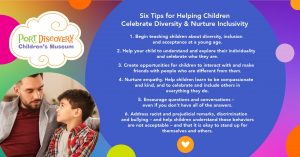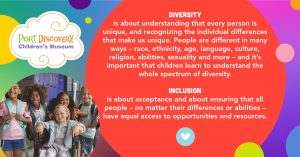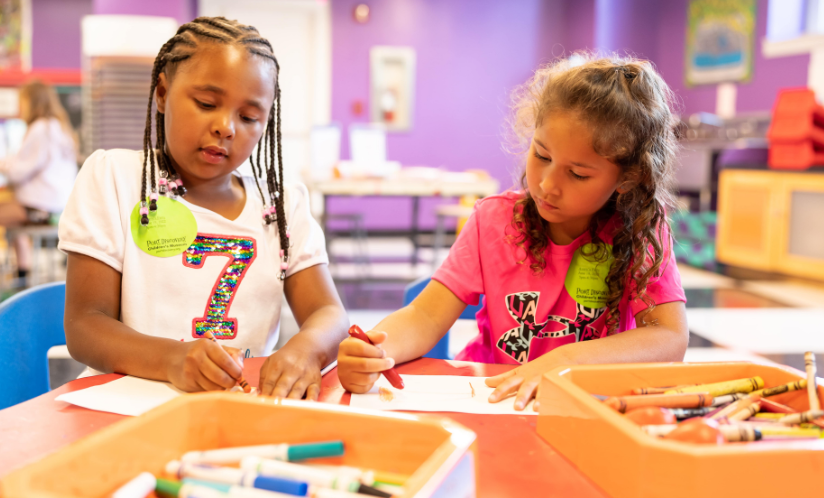
As parents, caregivers, educators, and human beings – we all want the very best for our children. We want them to grow up to be happy and healthy, in a world where they can achieve whatever they want to accomplish in life.
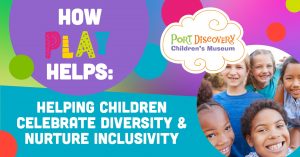
But, for as long as bias, racism, discrimination, and exclusion exist, the truth is that our children’s health, happiness, and opportunities will be limited, affecting their goals, life choices, mental and physical health, and more.
What do we do? While there’s no one solution – one thing that we can all try is to raise children to celebrate and value diversity, and help children learn to respect, value, and include all people (Scholastic).
What are diversity and inclusion?
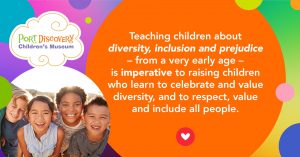
Teaching children about diversity, inclusion, and prejudice – from a very early age – is imperative to raising children who learn to celebrate and value diversity, and that respect, value and include all people.
As KidsConnect explains, diversity is about understanding that every person is unique, and recognizing the individual differences that make us unique. People are different in many ways – race, ethnicity, age, language, culture, religion, abilities, sexuality, and more – and it’s important that children learn to understand the whole spectrum of diversity.
Inclusion is about acceptance – learning to identify, accept, respect, and value people’s differences – and about ensuring that all people – no matter their differences or abilities – have equal access to opportunities and resources.
Six Tips for Helping Children Celebrate Diversity & Nurture Inclusivity
- Begin teaching children about diversity, inclusion and acceptance at a young age. Remember that children begin learning at birth, and that they form ideas about themselves and others long before they start school. Once your little one is playing with other children and starting to take note of same-ness and different-ness, try engaging your child in positive conversations about differences in the people in their lives, teaching them that differences do exist, are part of what makes everyone special, and are things to be celebrated!
- Support your child’s individuality. Help your child to understand and explore their individuality. Help them understand and celebrate who they are by exploring your family’s cultural and ethnic background and celebrate it together. Be vocal, explore traditions, and tell stories! Remind them that their uniqueness is special – and that their interests, abilities, appearance and beliefs are to be celebrated. By helping children valuing and understanding their individuality, you are also helping your children value the differences and individuality of others.
- Create opportunities for children to interact with and make friends with people who are different from them. One of the very best ways to nurture diversity, inclusion, and empathy is to expose children to people who are different from them – and play is a great way to do that. Encourage children to play with others by creating opportunities for children to interact and make friends with people who are different from them. Expose children to books, media, dolls, games, music, art, and more that celebrate and feature other cultures, races, ethnicities, religions, abilities, genders, traditions, family structures, sexuality, and more. Other things to try include attending cultural events, festivals and museums that celebrate people and cultures that are different than your family. During and after these activities, talk to your children about what they noticed, what questions they have, and what they learned.
- Nurture empathy. In addition to raising children that understand diversity and inclusivity, we want to raise children that compassionate and kind, and that celebrate and include others in everything they do. How do we do this? Help them develop the social and emotional skills that they’ll need to develop empathy and understanding. Showing children acceptance and caring, celebrating their individuality, and talking to them about feelings and the feelings of others can help children learn to become kind, caring and compassionate friends and people – and to have an attitude of inclusivity always.
- Encourage questions and conversations. Even though our children might think we have all of the answers, this is a good place to point out the obvious: We don’t! Sometimes that can make us hesitant to acknowledge or answer the many, many questions our children have – but as we teach our little ones about diversity and inclusion – it’s important to respond to their questions and comments even if you’re not sure what to say, because children often interpret a lack of response to mean that it’s not acceptable to talk about differences. For tips on how to respond to your child’s questions, check out this article from Scholastic, which provides ideas for what to do when you’re unsure about what to say, how to get a clearer idea of what your little one is asking, and how to shape your response to your child’s age and personality.
- Address racist and prejudicial remarks, discrimination and bullying. Remember that your children are always watching, observing and learning – and modeling the behaviors and reactions that they see from their parents, caregivers, and role models. When you address racist, prejudicial, and unkind remarks, discrimination, and bullying, you can help your child know – from a very early age – that name-calling, discrimination, bullying, and exclusion of any kind is not okay. You’re also teaching them that standing up for themselves and others is the right thing to do. By modeling inclusivity, celebrating diversity, and addressing inappropriate remarks and behavior, you’re helping your little learner understand how to act and respond as they face situations on their own and later in life.`
Interested in exploring other resources about helping children learn about, celebrate, and embrace diversity and inclusivity? In addition to the articles referenced above, here are some resources we’d suggest:
Resources for Talking to Children About Race
- Coming Together from Sesame Workshop, including articles, videos, and activities to explore together.
- Talking to Kids about Racial Injustice from Minnesota Children’s Museum, featuring a panel discussion featuring tips from experts on how caregivers can talk with children about race.
- Recommended Books for Kids and Teens from the editors at Resilient Educator
- A round-up of resources for parents from Starlight Children’s Foundation
- A variety of webinars, articles, stories, guides, books and more to help engage and talk to children about race from EmbraceRace.
- Resources for talking with children about racism and racialized violence, including tips for talking to children after traumatic racial incidents, compiled by Center for Racial Justice in Education.
- “What is Systematic Racism,” an 8-part video series designed to show how racism shows up across institutions, society, and more, from Race Forward.
- The Parent’s Guide to Teaching Kids About Diversity, from Scholastic.
Resources for Teaching Children About Diversity and Inclusion
- How to Teach Your Child to be an “Includer” from PBS.
- Teaching children about diverse families from BOLD
- 5 Ways to Help Children Be More Inclusive of Other Kids from Parents Magazine.
- Expert Tips on Teaching Diversity & Inclusion Through Play by The Genius of Play.
- Raising an Inclusive Child from Bright Horizons.
- 7 Tips for Raising Caring Kids from Harvard’s Making Caring Common Project.
- 13 Ways to Raise a Caring and Compassionate Child from Scholastic
- Resources on race and ethnicity, religion, ability, class, immigration, gender and sexual identity, bullying and bias, and more from Learning for Justice
- How to Raise Tolerant, Inclusive Kids from US News
